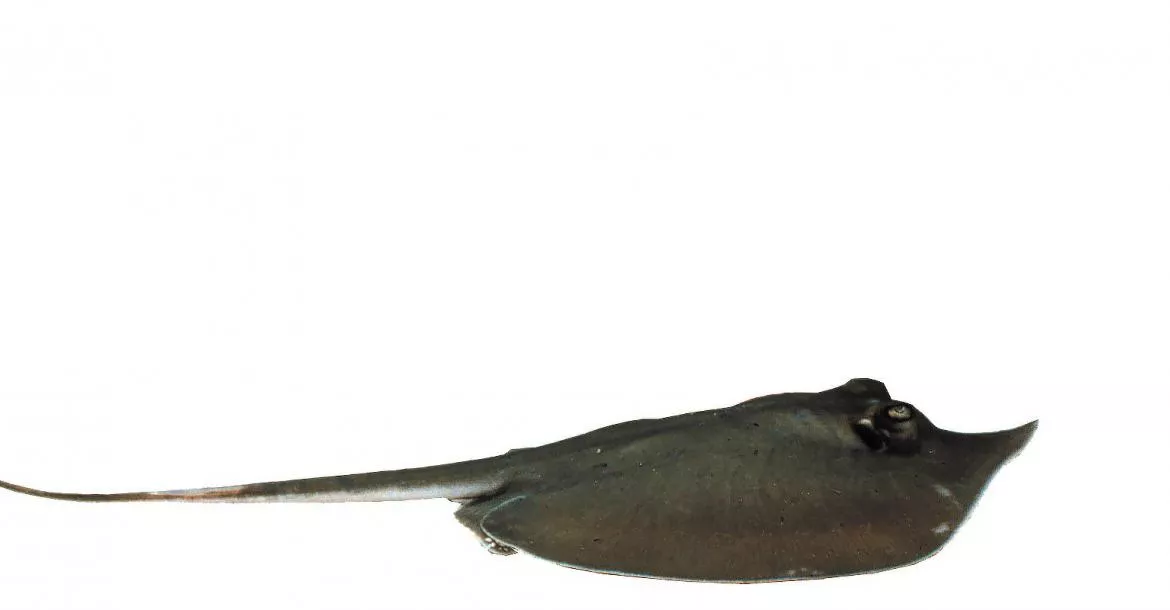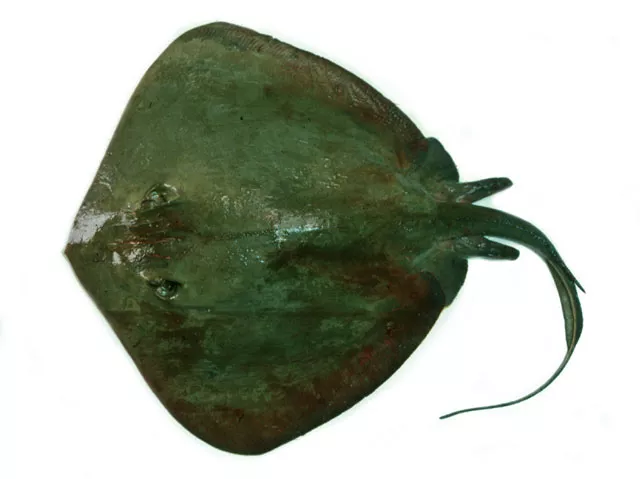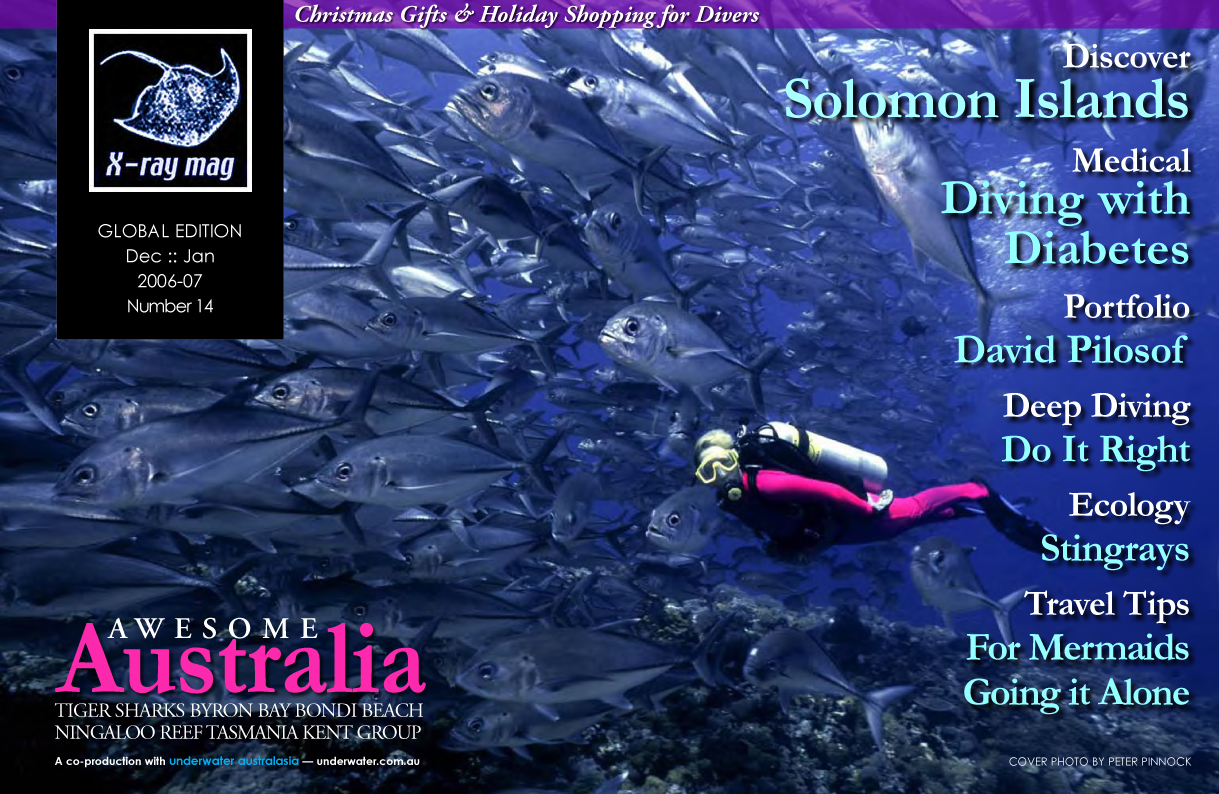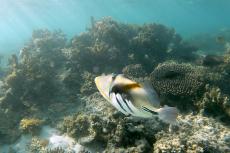"Stingray kills television host"
The headlines soon spread all over the world when the famous Australian philanthropist and television host, “crocodile hunter” Steve Irwin, was recently killed by a stingray, also known as a whiptail stingray.
Contributed by
Factfile
Ray and Skate Taxonomy
Rays and skates (Batoids) are divided into three orders:
(A) Order Rajiformes (true rays)
Within the order Rajiformes are the stingrays (Family no. 2). They are named for the venomous spines along the tail; these contain a poison that causes pain and may cause symptoms such as nausea, vomiting, fever, chills, muscle cramps, tremors, paralysis, fainting, seizures, elevated heart rate, and decreased blood pressure (depending on the species). Some species’ toxins and, or, sting can be fatal to humans.
- Family Anacanthobathidae (smooth skates).
- Family Dasyatidae (stingrays).
- Family Gymnuridae (butterfly rays).
- Family Hexatrygonidae (sixgill stingray).
- Family Myliobatidae (eagle ray). The largest of rays, including the giant manta ray. Most eagle rays have one poison-carrying spine.
- Family Plesiobatidae (deepwater stingrays).
- Family Potamotrygonidae (river stingrays).
- Family Rajidae (skates).
- Family Rhinobatidae (guitarfishes). Contain a body structure similar that of the sawfishes, but are not thought to be closely related.
- Family Urolophidae (round rays).
(B) Order Pristiformes (sawfishes)
Sawfishes are shark-like in form, having tails used for swimming and smaller pectoral fins than most batoids. The pectoral fins are attached above the gills as in all batoids, giving the fishes a broad-headed appearance. They have long, flat snouts with a row of tooth-like projections on either side. The snouts are up to 1.8 m long and 30 cm wide, and used for slashing and impaling small fishes and to probe in the mud for imbedded animals. Sawfishes can enter freshwater rivers and lakes. Some species reach a total length of up to 6 m.
1. Family Pristidae.
(C) Order Torpediniformes (electric rays)
Electric rays have organs in their wings that generate electricity, used to immobilize prey and for defense. The current is strong enough to stun humans.
Family Narcinidae
1. Family Torpedinidae
The ‘sting’, which gives these fishes their common name, is a modified dermal denticle mounted near the base of the tail, about one-third along its total length. The sting consists of a blade-like barb with serrations along both edges and a venom gland at the base. (see figure next page)
What kind of fish are stingrays?
Stingrays are rays, i.e. cartilaginous fishes related to skates and sharks. Rays and skates comprise a scientific so-called super-order of cartilaginous fishes named Batoidea.
Cartilaginous fishes do not have a skeleton of bone. Instead, it consists of cartilage, a type of dense connective tissue. It is composed of collagenous fibers and/or elastic fibers, and cells called chondrocytes, all of which are embedded in a firm gel-like ground substance called the matrix.
Over 500 species
There are more than 500 species of rays and skates in twelve families, including stingrays, skates, electric rays, guitarfishes and sawfishes (Box 1). The Batoids are closely related to sharks. In fact, in the early part of the Batoid life cycle, they look much alike young sharks. It is interesting to notice that there while there are only approximately 370 extant species of sharks—which is over 100 less species than rays and skates—sharks have received considerably more attention than rays and skates, both from the general public and from the scientific community... at least until now.
The Dasyatids
The scientific name for the family of stingrays, or whiptail stingrays, is Dasyatids. They are common in tropical coastal waters throughout the world. Freshwater species are also known from e.g. Asia and Africa. The species of the genera Potamotrygon, Paratrygon, and Plesiotrygon are thus endemic to the freshwaters of South America.
Rays range in size from just a few cm to several meters wide. The smallest ray is probably the short-nose electric ray, which is the size of a pancake; it is only 10 cm across and weighs about half a kilo. The biggest ray is the manta, which can reach a width of over three meters as an adult.
Their habitat
Most species live on the sea floor, in a variety of geographical regions—many in coastal waters and a few species live in deep waters. Most batoids have a rather cosmopolitan distribution in tropical and subtropical marine environments or temperate waters. Only a few species, like manta rays, are oceanic, i.e. they live in the open sea. A couple of species are confined to freshwater. Some batoids can live in brackish bays and estuaries.
Bottom-dwelling batoids breathe by taking water in through so-called spiracles, rather than through the mouth as most fishes do, and passing it outward through the gills. Their mouths and gills (like almost all rays) are located on the underside of their flat bodies making breathing an issue if you lie on or are more or less buried in sand.
To overcome this hurdle they have developed extremely large spiracles (spiracles are the openings positioned just behind the eyes through which a shark or ray can suck in oxygen rich water to flush over the gills). Through this mechanism rays are able to remain motionless for hours at a time.
Many whiptail stingrays are restricted to marine habitats but some are known to migrate into brackish estuarine environments.
A few species can live year round in both fresh and salt water. Whiptail stingrays are benthic. They spend much time buried with only their eyes sticking out. This is a defensive strategy rather than a stealthy way to surprise prey. Because they tire easily when swimming, remaining buried is the ideal way to avoid becoming lunch.
Whiptail stingrays are heavily preyed upon by a number of shark species (especially by hammerheads). An exception to the benthic lifestyle is the pelagic stingray Dasyatis violacea. Although this ray can also be found on the substrate it is a free swimming ray that preys on oceanic squid and mid water fishes, which it manipulates by holding them between its pectoral fins.
Because of its unique behavior the Pelagic Stingray is sometimes categorized in its own genera—Pteroplatytrygon. Whiptail stingrays usually inhabit shallow coastlines down to 100 or 200 meters, but some species can be found at 600 meters or even deeper.
Diet
Most batoids have developed rounded teeth for crushing the shells of snails, clams and crustaceans and some fish, depending on the species of ray or skate. Manta rays are plankton feeders Whiptail stingrays known to eat mollusks, crustaceans, jellyfish, and bony fishes. The recorded stomach contents of one honeycomb stingray included: eight threadfin bream, three mackerel, eight ponyfish, eight cardinalfish, three sardines, three anchovies, two flatfish, one mojarra, four flatheads, three pufferfish, five squids, two crabs, and two mollusk shells!
Whiptail stingrays are known to gather at fishermen’s fish cleaning stations to take advantage of the scraps that end up on the seabed. In some locations, such as Stingray City in Grand Cayman and Hamelyn Bay in Western Australia, their tolerance towards humans has reached the point where they will eagerly accept scraps straight from the hands of tourists. Although these interactions have altered the stingrays natural behavior, there is no evidence that they have lost the ability to hunt on their own. Stingray City tours are now a multimillion dollar industry that attracts hundreds of tourists daily.
Although the large Southern Stingrays get quite aggressive while they are competing for handouts of squid, they rarely harm the tourists, preferring to back off when trodden on rather than use their defensive tail stings. Traditionally, stingrays were feared by fishermen and beach goers alike, so the positive press that the rays receive from these encounters is a welcome change that may be a critical factor in their future survival.
Reproduction
The batoids are extraordinarily varied in their mode of reproduction. Most rays and skates are benthic, lying on the substrate for extended periods, often to some extent buried. Some forms, however (particularly the eagle, cownose, manta and devil rays) are secondarily pelagic, swimming strongly in mid-water and rarely resting on the bottom.
Mating season occurs in the winter. When a male is courting a female, he will follow her closely, biting at her pectoral disc. During mating, the male will go on top of the female (his belly on her back) and put one of his claspers into her vent. Most rays are viviparous bearing live young in “litters” of five to ten. Therefore, batoid eggs, unlike those of most other fishes, are fertilized inside the female’s body. The female holds the embryos in the womb without a placenta. Instead, the embryos absorb nutrients from a yolk sac, and after the sac is depleted the mother provides uterine milk.
Skate egg cases are often rectangular with extended tendrils at each corner, which serve to anchor them to bottom growth (washed ashore, the empty cases are known as “mermaid’s purses”). Fetal electrical rays (Torpediniformes) are nourished by protein-rich secretions from the uterine wall, while fetal stingrays (Myliobatiformes) get their nourishment delivered to them via secretions from pseudo-placentae that enter their bodies through the spiracles.
Are stingrays dangerous?
Stingrays are not, as their close relatives, the sharks, known for being dangerous. While sharks through history have worked up quite a reputation among other things thanks to their impressive denture, large bodies and sometimes aggressive behaviour the rays have rarely made much headlines and for a good reason. Rays do not present a direct threat to humans venturing into the water. Unlike sharks, they can’t eat or bite us, nor do they usually display any aggressive behaviours but tend to mind their own business. But that doesn’t mean that stingrays are not dangerous at all.
Like so many other animals, they can become defensive if they feel cornered or bothered and their stinging barb, a cartilaginous spine situated on the root of their tail, can inflict some nasty wounds.
Self-defence
Stingrays use their stinging spines only in self-defense. Dasyatids generally do not attack aggressively or even actively defend themselves. When threatened, their primary reaction is to swim away. However, when they are attacked by predators or stepped on, the barbed stinger in their tail is whipped up. This attack is normally ineffective against their main predator, namely sharks.
Humans are usually stung in the feet (depending on the size of the stingray). The stinger often breaks off in the wound, which is non-fatal to the stingray, and will be re-grown. Contact with the stinger causes local trauma (from the cut itself), pain and swelling from the venom, and possible later infection from bacteria on parts of the stinger left in the wound.
The ‘sting’, which gives these fishes their common name, is a modified dermal denticle mounted near the base of the tail, about one-third along its total length. The sting consists of a blade-like barb with serrations along both edges and a venom gland at the base. The serrae point toward the base of the spine, making removal difficult and very painful.
The venom is a fairly powerful nerve toxin which affects the heart in complex and dangerous ways. Worldwide, several stingray-related fatalities are recorded every year—as sometimes occurs when a diver swims too close over a partially buried ray and is stung in the neck or chest.
As regards to Steve Irwin’s fatal accident, it is widely regarded as an unlucky combination of unfortunate circumstances—a freak accident in other words—but it goes to show that divers and snorkellers should always keep a minimum distance from stingrays of one to two meters. ■
References
Hamlet, W.C. 1999. Sharks, Skates, and Rays: The Biology of Elasmobranch Fishes. The Johns Hopkins University Press.
Froese, R., Pauly, D. Eds., 2006. FishBase. World Wide Web electronic publication. www.fishbase.org, version (07/2006).
Nelson, J.S. 2006. Fishes of the world. 4th Ed. John Wiley and Sons ltd.



























